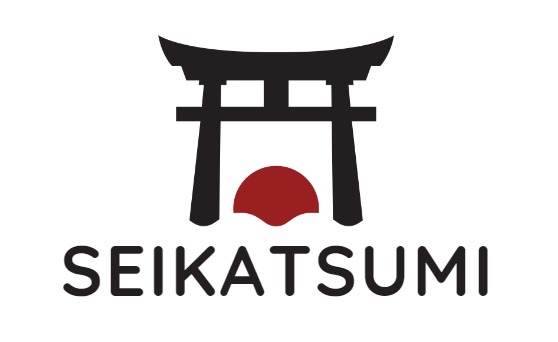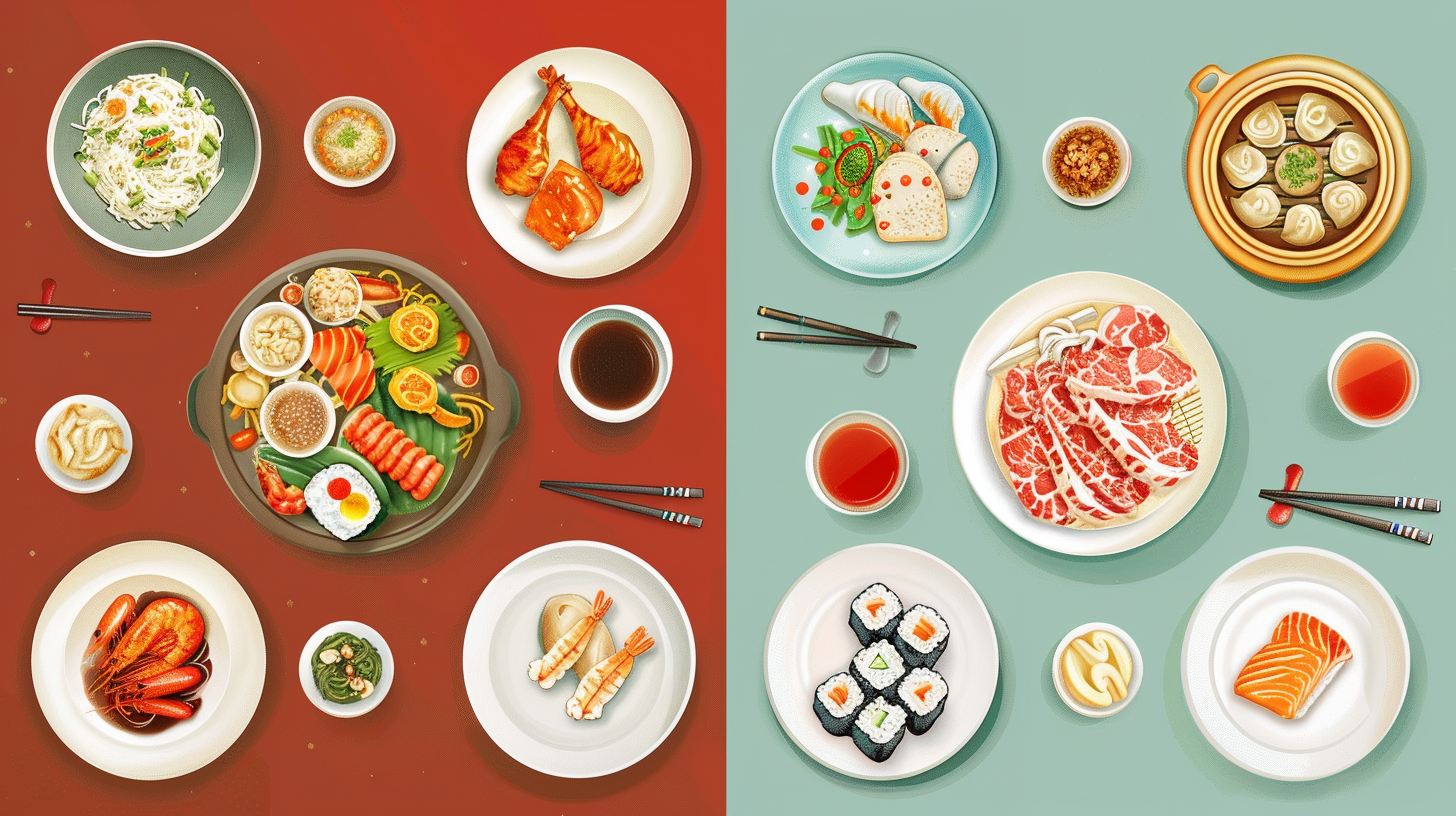Are you just as fascinated by Chinese vs Japanese Food cuisine as I am? I completely share your enthusiasm!
I understand the joy it brings to discover the unique flavors and characteristics of each cuisine. That’s why I’ve spent countless hours researching to make the differences and specialties more accessible to you!
I am thrilled to take you on a culinary journey through Chinese vs Japanese Food cuisine. The rich cultural diversity of both countries is reflected in their delicious dishes.
So, why wait? Dive in and experience the variety of flavors! 🙂
Chinese vs Japanese Food: Historical Origins
When it comes to Chinese vs Japanese Food, the historical origins of each country’s food culture are fascinating.
Here are the ancient roots of both Chinese vs Japanese Food:
Ancient Chinese Cuisine
Chinese cuisine has a long and rich history that dates back thousands of years. The earliest known Chinese cookbook, “The Classic of Food and Drink,” dates back to the Zhou dynasty (1046-256 BCE).
During this time, food was seen as a way to maintain health and balance in the body, and many of the ingredients used in ancient Chinese cuisine were chosen for their medicinal properties.
One of the most important ingredients in ancient Chinese cuisine was rice.
Rice was not only a staple food, but it was also used to make wine, vinegar, and other fermented products.
Other common ingredients included soybeans, wheat, millet, and a variety of meats and vegetables.
Traditional Japanese Cuisine
Like Chinese cuisine, Japanese cuisine has a long and rich history that dates back thousands of years.
However, the origins of Japanese cuisine are quite different from those of Chinese cuisine.
Japanese cuisine began to develop in isolation from other cultures due to Japan’s geographic location.
The earliest known Japanese cookbook, “The Honcho Shokkan,” dates back to the 16th century.
However, the roots of Japanese cuisine can be traced back even further to the Jomon period (14,000-300 BCE). During this time, the people of Japan were primarily hunter-gatherers, and their diet consisted of fish, shellfish, wild game, and a variety of plants.
Over time, Japanese cuisine began to evolve as the country became more connected with other cultures.
Chinese influence on Japanese cuisine dates back centuries, when early traders and diplomats from China visited Japan and introduced their culinary traditions. During the Tang dynasty (618-907 AD), Chinese culture was at its peak, and Japan was eager to adopt new ideas and practices.
Hey you! Are you interested in more food trends? Then be sure to check out our top food articles! You definitely can’t miss it!
Japanese Sushi Essentials: The Best Guide to Enjoying Traditional Flavors 2024
Low Carb Japanese Food 2024: The Best Guide for Delicious and Healthy Food
Japanese Bento Box: Your Guide Preparing The Best Bento Box In 2024!
Key Ingredients
When it comes to Chinese vs Japanese Food, the key ingredients used in each cuisine are quite different.
Here are some staple foods, spices and seasonings, and proteins commonly used in Chinese vs Japanese Food:
Staple Foods
Rice is a staple food in both Chinese vs Japanese Food, but the type of rice used differs.
Japanese cuisine typically uses short-grain rice, which is sticky and perfect for making sushi, while Chinese cuisine uses long-grain rice, which is fluffy and ideal for stir-fries.
Noodles are also a staple in both cuisines, but again, the type of noodle used differs.
Japanese cuisine uses soba (buckwheat) noodles and udon (thick wheat) noodles, while Chinese cuisine uses egg noodles and rice noodles.
Spices and Seasonings
Chinese cuisine is known for its bold, spicy flavors, and this is largely due to the use of Sichuan pepper, chili peppers, and ginger. Soy sauce, oyster sauce, and hoisin sauce are also commonly used in Chinese dishes.
Japanese cuisine, on the other hand, tends to be more subtle in flavor. Soy sauce, mirin (sweet rice wine), sake (Japanese rice wine), and dashi (fish stock) are commonly used in Japanese dishes.
Wasabi, a spicy green paste made from Japanese horseradish, is also a popular condiment.
Proteins
Both Chinese vs Japanese Food use a variety of proteins in their dishes. Pork and chicken are commonly used in Chinese cuisine, while seafood, such as sushi-grade fish and shellfish, is more prevalent in Japanese cuisine.
Tofu is also a popular protein in both cuisines, but it is used more frequently in Japanese dishes.
Cooking Techniques
When it comes to Chinese vs Japanese Food, the cooking techniques used are quite different.
Here are some differences between Chinese vs Japanese Food cooking methods:
Chinese Cooking Methods
Chinese cuisine is known for its bold flavors and textures, which are achieved through a variety of cooking techniques. Some of the most common Chinese cooking methods include:
- Stir-frying: This involves cooking ingredients quickly over high heat in a wok or frying pan. Stir-frying is great for preserving the flavor and texture of the ingredients while also creating a delicious, crispy exterior.
- Deep-frying: This involves submerging ingredients in hot oil until they are crispy and golden brown. Deep-frying is often used for making appetizers and snacks like spring rolls and dumplings.
- Steaming: This involves cooking ingredients using steam, which helps to preserve their natural flavors and nutrients. Steaming is often used for cooking seafood, vegetables, and rice.
Japanese Cooking Methods
Japanese cuisine, on the other hand, is known for its delicate flavors and emphasis on presentation. Some of the most common Japanese cooking methods include:
- Grilling: This involves cooking ingredients over a charcoal or gas grill. Grilling is great for adding a smoky flavor to ingredients like meat, fish, and vegetables.
- Simmering: This involves cooking ingredients in a liquid over low heat for an extended period of time. Simmering is often used for making stews and soups.
- Sushi-making: This involves preparing sushi rice and combining it with various ingredients like raw fish, vegetables, and sauces. Sushi-making requires a lot of skill and precision, as the ingredients must be arranged in a visually pleasing way.
The cooking techniques used in Chinese vs Japanese Food are quite different.
Chinese cuisine focuses on bold flavors and textures, while Japanese cuisine emphasizes delicate flavors and presentation.
Flavor Profiles
When it comes to comparing Chinese vs Japanese Food, one of the most noticeable differences is their flavor profiles.
Both cuisines have rich and distinct flavors, but they differ in the way they are achieved.
Chinese Flavor Palette
Chinese cuisine is known for its bold and complex flavors. It often combines sweet, sour, salty, and spicy flavors in one dish. Soy sauce, oyster sauce, and hoisin sauce are commonly used to add depth to the dishes. Garlic, ginger, and scallions are also popular ingredients that add aroma and flavor.
Chinese cuisine also makes use of a wide range of spices such as Sichuan peppercorns, star anise, and cinnamon to create a unique flavor profile.
In addition to the use of sauces and spices, Chinese cuisine also makes use of different cooking techniques to achieve the desired flavors. Stir-frying, deep-frying, and braising are some of the common techniques used in Chinese cooking.
These techniques help to create a crispy texture on the outside while keeping the inside tender and juicy.
Japanese Flavor Palette
On the other hand, Japanese cuisine is known for its delicate and subtle flavors. It emphasizes the natural taste of the ingredients and aims to highlight their freshness and quality.
Soy sauce, mirin, and sake are commonly used in Japanese cuisine to add umami flavor to the dishes.
Dashi, a broth made from kombu seaweed and bonito flakes, is also a staple in Japanese cooking and provides a rich and savory flavor to the dishes.
Japanese cuisine also makes use of different condiments such as wasabi, pickled ginger, and yuzu kosho to add flavor and freshness to the dishes.
Presentation is also an important aspect of Japanese cuisine, and dishes are often arranged in an aesthetically pleasing manner.
Chinese vs Japanese Food have unique and distinct flavor profiles.
While Chinese cuisine is known for its bold and complex flavors, Japanese cuisine emphasizes the natural taste of the ingredients and aims to highlight their freshness and quality.
Cultural Significance
As a food enthusiast, I find it fascinating to learn about the cultural significance of different cuisines. Both Chinese vs Japanese Food have a rich history and unique cultural significance that makes them stand out in the culinary world.
Here are some of the cultural significance of Chinese vs Japanese Food:
Dining Etiquette
In both Chinese vs Japanese Food cultures, dining is not just about satisfying hunger but also about building relationships and showing respect. Table manners play a crucial role in both cultures. In Japan, it is customary to say “itadakimasu” before a meal, which means “I humbly receive.”
It is also polite to slurp noodles loudly as it is a sign of appreciation for the cook. In contrast, in Chinese culture, it is customary to use chopsticks while eating, and it is considered impolite to point them at someone or leave them sticking upright in a bowl of rice.
In both cultures, sharing food is a common practice, and it is considered polite to offer food to others before serving yourself.
Also, it is considered impolite to waste food, and one should finish their plate as a sign of respect to the host.
Food in Festivals
Festivals are an essential part of both Chinese vs Japanese Food cultures, and food plays a crucial role in these celebrations.
In Japan, the New Year’s celebration is known as “Oshogatsu,” and it is customary to eat “osechi,” a traditional Japanese New Year’s meal that consists of various dishes with symbolic meanings. For example, black beans represent health, while fish cakes represent wealth.
Similarly, in China, the Lunar New Year is the most important festival, and it is celebrated with a grand feast called “Nian Ye Fan.”
The meal consists of various dishes, and each dish has a symbolic meaning. For example, fish represents prosperity, while dumplings represent wealth.
Frequently Asked Questions
What are the main differences between Chinese and Japanese cuisine?
Chinese cuisine is diverse, often characterized by bold flavors and heavy use of garlic and ginger, while Japanese cuisine is more subtle, focusing on the natural flavors of fresh ingredients.
What are typical ingredients in Chinese and Japanese cooking?
Chinese cooking commonly uses ingredients like soy sauce, rice, noodles, and a variety of meats and vegetables. Japanese cooking often features rice, seafood, soy products, and vegetables, with a distinct use of seasonings like miso and wasabi.
How do serving styles differ in Chinese and Japanese food?
Chinese meals often include a variety of dishes served family-style, meant for sharing, whereas Japanese meals usually consist of individual portions, often presented with careful attention to aesthetics.
If you liked this blog article about Chinese vs Japanese Food, don’t forget to follow us on Pinterest so you don’t miss any more food tips.
Let us know, which of the above is your favorite dish!


